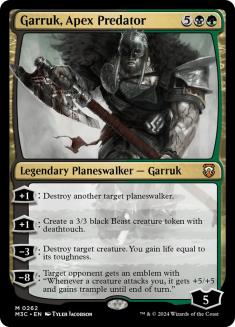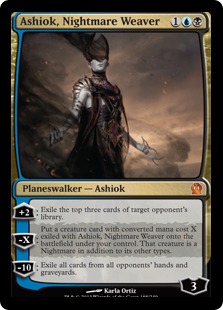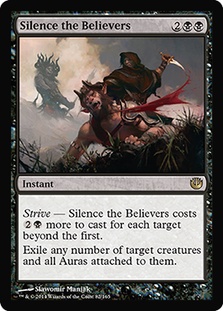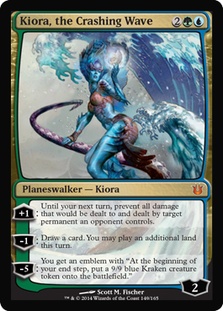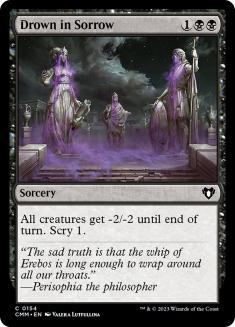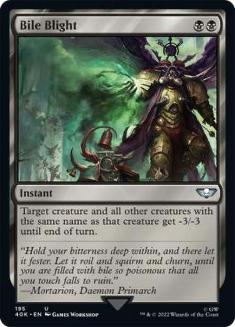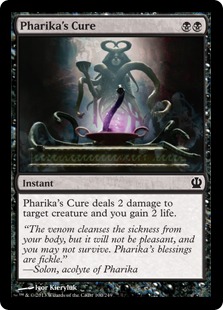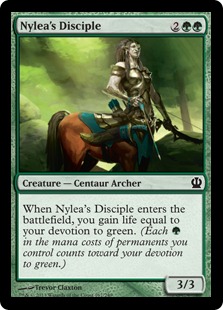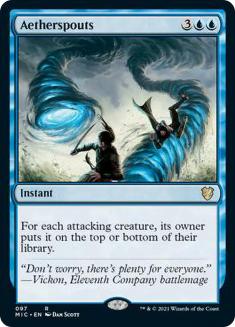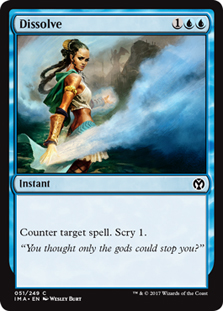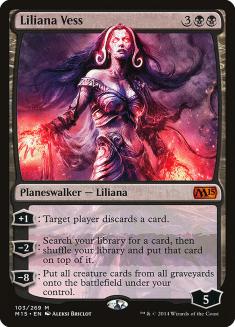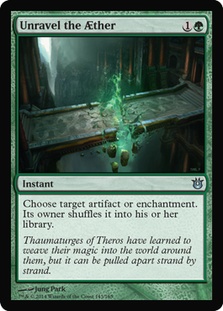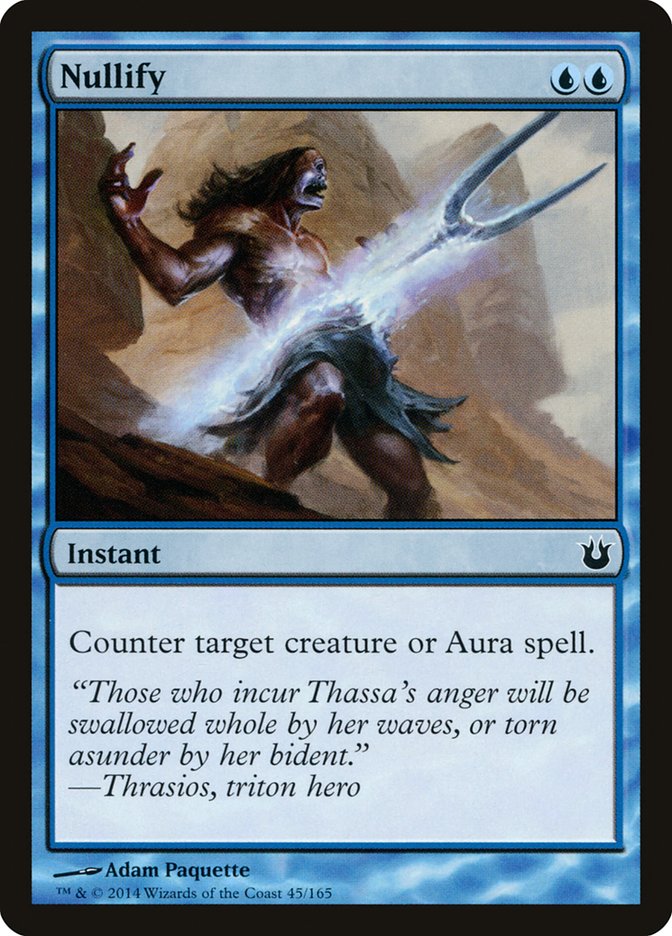Sultai Walkers has been amazing these last few weeks online. I admitted on multiple occasions that I thought that pre-rotation Esper was weak at certain
times, but my passion for control wouldn’t allow a shift to a different archetype. That is not the case with Sultai Walkers. Continuous testing through
hours and hours of three round tournaments has provided me with valuable feedback and a cautious amount of optimism. The Pro Tour didn’t really change much
in the metagame online or in live magic, but it has empowered a few existing decks. Green midrange decks dominated the top 8, and even though a U/B Control
deck powered its way into the fray, I believe it is too weak against a field of powerful creatures. The power level of the green critters that the Sultai
Walker’s shell contains is too great to ditch for more control spells at this time in Standard.
While playing Magic Online, I have faced everything you could imagine. From Mono-Red Aggro to U/B Control, the results are still the same. U/B Control is
easily the toughest matchup after sideboard, but Mono-Red Aggro is an absolute joke after the inclusion of eleven sideboard cards to fend off the menace.
An eleven card sideboard plan may sound extreme, but the reason is not the prevalence of the one-drop armada but the difficulty to board out spells against
the other decks of the format. Against midrange green decks, Jeskai Aggro, U/B Control, or anything not hyper aggressive, there are only 3-4 cards that can
be cut. I have been reduced to removing one Sylvan Caryatid to make room after sideboard, and it doesn’t feel good.
The four copies of Hero’s Downfall, Courser of Kruphix, and Sultai Charm along with three copies of Prognostic Sphinx and Dig Through Time are not removed
for any matchup. I realize the cost of Dig Through Time in most circumstances, but after the one-for-one slugfest, we need a way to “dig” out of the trench
created. As far as the other cards, each piece is necessary for the synergistic way the deck plays out in each matchup. For those reasons, the sideboard
contains a heavy anti-aggro plan, which actually gives us the advantage after sideboard. The difficulty of sideboarding does not exist when playing against
aggro decks luckily. Cards like Thoughtseize, Ashiok, Nightmare Weaver, Garruk, Apex Predator, Kiora, the Crashing Wave, and Silence the Believers are
easily cut for the eleven card tidal wave against creature strategies. Silence the Believers has the allure of being strong against hyper aggressive decks,
but the four mana price tag makes it pretty bad. I’m packing so much removal and heat after board that any spell that costs a ton and doesn’t kill them,
like Prognostic Sphinx, is unnecessary.
Creatures (11)
Planeswalkers (6)
Lands (25)
Spells (18)
- 4 Thoughtseize
- 4 Hero's Downfall
- 1 Silence the Believers
- 2 Aetherspouts
- 4 Sultai Charm
- 3 Dig Through Time
Sideboard

Now is as good a time as any to talk about how to sideboard with Sultai Walkers. I touched on this briefly in my last piece, but here’s a more detailed guide given the games that
I’ve played.
VS Mono-Red Aggro/Mono-Black Aggro
This strategy will give you the game the majority of the time against the most aggressive of decks in Standard. I have faced it at least twenty times
online, and even my mulligans to five that included a Drown in Sorrow left me feeling like a million bucks after victory. The only alteration I would make
to this sideboard plan is the removal of one Aetherspouts for the Silence the Believers against Mono-Black. Silence the Believers is far too slow for a
one-for-one against Mono-Red, but Mono-Black is much slower with far less reach. Any attempt to bestow a creature can result in a disaster for them if you
are fortunate enough to have the sneaky one-of in your hand at the right time.
Out:
In:
VS Green Midrange
I am aware of how many variations of green midrange decks there are in the forms of Temur, Abzan, Sultai, G/R Monsters, and some four color strategies.
Lucky for Sultai Walkers, the maindeck is built to beat those types of decks already. The bad news is that sideboarding can be difficult. This sideboard
setup can be altered to your specific style of play, but this is how I would approach most of these decks.
Out (vs Abzan and Sultai Midrange):
In (vs Abzan and Sultai Midrange):
Out (vs Temur and G/R Monsters):
In (vs Temur and G/R Monsters):
This is a very basic strategy for the midrange matchup that must be tweaked depending on your opponent’s list. I love me some Thoughtseize, however,
drawing them later on provides us with issues and is the reason for dropping it to three. If your midrange opponent is playing a much slower strategy that
doesn’t include an array of three drops, then you can keep in the full arsenal and possibly cut the other Aetherspouts. Aetherspouts is really for Wingmate
Roc, Hornet Queen midrange decks, and isn’t the greatest against those that don’t pack the one-card army threats.
Kiora, the Crashing Wave is in the same boat, which is good against most midrange decks, but very bad in multiples. If your opponent is playing a midrange
deck that has access to red and multiple hasted creatures, then she can be removed entirely. You have just three cards that come in against all of these
different decks and can remove your choice of cards between Thoughtseize, Kiora, the Crashing Wave, or Aetherspouts. I am still testing the numbers and
there isn’t an exact science for this yet.
An opponent playing Temur could be using a midrange strategy that banks on planeswalkers and more control, where a different opponent playing the same
colors is midrange too, but much more creature oriented. Your sideboarding really depends on what you’ve seen game 1. Keep in mind that the cards you are
taking out against these decks are still very good, but room has to be made for the security of Dissolve and the advantage of Liliana Vess.
VS Abzan and Jeskai Aggro
Multiple Jeskai Aggro decks and an Abzan Aggro deck breached the top 8 of Pro Tour Khans of Tarkir. Jeskai Aggro is a much harder matchup than Abzan in
this situation because of the reach that red provides them. Both matchups are quite winnable, however. The maindeck is suited to defeat these decks with an
array of one-for-ones, and a finisher in Prognostic Sphinx that is all kinds of good. The sideboarding in these matchups is also a lot easier in comparison
to their midrange counterparts.
Out (vs Jeskai Aggro):
In (vs Jeskai Aggro):
Out (vs Abzan Aggro):
In (vs Abzan Aggro):
Thoughtseize is clearly the weakest card of the bunch and can be cut easily. Kiora, the Crashing Wave is fairly weak against these two decks and is
absolutely terrible against Jeskai Aggro. There are many situations against Abzan Aggro that you can remove one of their two threats at the end of their
turn, and then untap and Kiora can swoop in to nullify the remaining one. For this reason, Kiora isn’t too bad in this matchup. Bile Blight is an all-star
in both, killing the majority of threats early on and allowing Hero’s Downfalls and Sultai Charms to be used later in the game. Because of the Pro Tour, I
switched the removal around in the sideboard and dropped a Pharika’s Cure, but I like having one in there to give a small boost in life against the faster
aggro decks.
VS Jeskai Ascendancy
This matchup is one of the easiest ones I’ve played in quite some time. Let’s put aside the fact that Thoughtseize is amazing against combo, removal for
creatures is good, and Ashiok, Nightmare Weaver is an absolute house. The four maindeck Disenchant effects are enough to put this matchup over the edge.
I’ve only played against this type of deck online once, and it was an easy victory. I’ve played against it some in live testing, which yielded the same
result. The sideboard cards for the matchup are limited, but Liliana Vess and the two Dissolve are more fuel for the fire.
Out:
In:
The Dissolve + Thoughtseize combination is one of the better plans against combo, even with only packing a couple of counters in the sideboard. The deck
requires creatures to win, which gives control decks an additional advantage due to removal being live. Even though you can’t kill Sylvan Caryatid, the
other creatures are vulnerable to removal. As I mentioned earlier, Jeskai Ascendancy is very fragile against a deck with four copies of Sultai Charm in the
maindeck and an additional answer in Unravel the Aether after sideboard.
I haven’t spoken a great deal about Unravel the Aether and some may question the importance of that one-of in the board, but it is absolutely necessary
against any of the Gods that you may come in contact with. I had an opponent play an Erebos, God of the Dead against me on turn 4 and my deck just fell
apart. That God, along with the others, are so seldom played, which is the reasoning for running just one answer in the sideboard. Silence the Believers is
an additional answer in the maindeck, but some of the Gods do a lot of damage well before they are activated. Unravel the Aether is there to battle the
Gods but useful in this matchup for obvious reasons.
VS U/B Control / Esper Control
This is going to be a very rare matchup, but I wanted to include it in the sideboarding guide. Sideboarding in the control mirror is very important but
simple. We all know which cards are ineffective and which are powerful against decks that don’t pack the creatures.
Out:
In:
The Gift of Esper
I adamantly suggest that you stick with Sultai Walkers at this point in the Standard metagame, but you diehard Esper folk have requested my take on
traditional “Soorani” control and here it is:
Creatures (1)
Planeswalkers (8)
Lands (24)
Spells (27)
- 2 Thoughtseize
- 2 Despise
- 4 Hero's Downfall
- 4 Dissolve
- 2 Bile Blight
- 3 Nullify
- 2 Banishing Light
- 4 End Hostilities
- 4 Dig Through Time
Sideboard

This list is relatively untested in the real world. A couple games with a buddy are the extent that I’ve played this deck, because of my interest in Sultai
Walkers these last few weeks. The best part about Esper is the power of Elspeth, Sun’s Champion that is sorely missed in control decks across the board.
Elspeth, Sun’s Champion may be the most powerful card in Standard, but it doesn’t have a great fit in the current metagame. Everyone is packing either a
full complement of Hero’s Downfalls, Utter Ends, Banishing Lights, or a mix of the three. It is a tough world for the soldier creator to survive even if
the opponent doesn’t have those spells because of how many fliers are being played at the moment.
Prognostic Sphinx is easily the most resilient of the win conditions in a typical control deck, but because of the necessity of End Hostilities for Esper,
Prognostic Sphinx hangs out in the sideboard and lets Elspeth, Sun’s Champion take game 1 home. Prognostic Sphinx would have been better in a world of
Supreme Verdict from the turn before, but now that both spells share the same curve slot, it leads to awkward situations. I think Prognostic Sphinx was
even powerful in last Standard, but the ineffectiveness in a deck with four Supreme Verdict or End Hostilities is glaringly obvious. In no circumstance
would I board out a Prognostic Sphinx in Sultai Walkers, but here they have to remain a boarded in option in matchups that don’t require four End
Hostilities.
The card I’m most excited about is Nullify in this format. I have two Nullify in the maindeck, but I would gladly fit the third in at some point if I were
to play Esper. Nullify is an amazing card in a format full of midrange decks that must use the creatures to obtain victory. Bile Blight is truly a hit or
miss card, but Nullify on turn 2 through 50 is powerful in most circumstances. Even against decks that pack only a few creatures in a control shell,
countering a Prognostic Sphinx eventually is just fine. Nullify will rarely be a dead card for you, where the other early spells in the Esper arsenal could
be.
The early turns of hand disruption and removal has synergy with the three drop slot, which contains universal answers and the first of the win conditions.
Ashiok, Nightmare Weaver wins the position over Brimaz, King of Oreskos using the same logic behind the Prognostic Sphinx decision. This deck is utilizing
more of the classic control shell and using planeswalkers to finish the job in comparison to last season’s “tap-out” strategy. You still get to slam a
planeswalker the turn after removing a threat with a Dissolve, Nullify, or removal spell, but that isn’t happening every turn. Because of the lack of
lifegain, there’s a two Despise and two Thoughtseize split in the maindeck instead of four copies of Thoughtseize. The only lifegain accessible that isn’t
trash is Nyx-Fleece Ram, and that is not a maindeck card at this point. It is hard to consider Sorin, Solemn Visitor as a way to gain life, but it is
possible if the board is stable enough. An Elspeth, Sun’s Champion brigade can gain you a quick six life after dropping her buddy Sorin into the
battlefield prior to attacks, which is nice. The planeswalkers can usually seal the deal against most decks, but expect to sneak in a Prognostic Sphinx or
two into the deck after the first game against all decks that don’t require the board to be swept time after time.
This Esper deck is not ready to win a Grand Prix, but is a decent starting point for anyone interested in reviving the old shard. I’m still all about
Sultai Walkers at this point, which is slightly different from the last list I have posted after weeks of testing online. The removal of Nissa, Worldwaker
was inevitable, because of the strength of Prognostic Sphinx and it being more effective than the green walker in almost every scenario. The only aspect of
Nissa that I’ll miss is the instant pressure that can be created on enemy planeswalkers, which we don’t have access to anymore. The other changes in the
maindeck are the inclusion of a fourth Opulent Palace over the Temple of Deceit, two Aetherspouts over the two Drown in Sorrows, and some sideboard
tweaking.
These lists, along with others I have and will continue to work on, will be constantly changed and updated because of testing results from live and online
magic. My Twitter is used for all things control, so continue to follow me for updates that are posted prior to an article if you need that polished list
sooner for an event. Although I’m not on the Esper train right now, I know it has the potential to be great, so give it a shot and let me know how you’re
performing with it!

